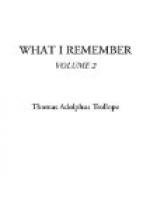She has been compared to the portraits of Savonarola (who was frightful) and of Dante (who though stern and bitter-looking, was handsome). Something there was of both faces in George Eliot’s physiognomy. Lewes told us in her presence, of the exclamation uttered suddenly by some one to whom she was pointed out at a place of public entertainment—I believe it was at a Monday Popular Concert in St. James’s Hall. “That,” said a bystander, “is George Eliot.” The gentleman to whom she was thus indicated gave one swift, searching look and exclaimed sotto voce, “Dante’s aunt!” Lewes thought this happy, and he recognised the kind of likeness that was meant to the great singer of the Divine Comedy. She herself playfully disclaimed any resemblance to Savonarola. But, although such resemblance was very distant—Savonarola’s peculiarly unbalanced countenance being a strong caricature of hers—some likeness there was.
Her speaking voice was, I think, one of the most beautiful I ever heard, and she used it conscientiously, if I may say so. I mean that she availed herself of its modulations to give thrilling emphasis to what was profound in her utterances, and sweetness to what was gentle or playful. She bestowed great care too on her enunciation, disliking the slipshod mode of pronouncing which is so common. I have several times heard her declare with enthusiasm that ours is a beautiful language, a noble language even to the ear, when properly spoken; and imitate with disgust the short, snappy, inarticulate way in which many people utter it. There was no touch of pedantry or affectation in her own measured, careful speech, although I can well imagine that she might have been accused of both by those persons—unfortunately more numerous than could be desired—who seem to take it for granted that all difference from one’s neighbour, and especially a difference in the direction of superiority, must be affected.
It has been thought by some persons that the influence of George Henry Lewes on her literary work was not a fortunate one, that he fostered too much the scientific bent of her mind to the detriment of its artistic richness. I do not myself hold this opinion. I am even inclined to think that but for his companionship and encouragement she might possibly never have written fiction at all. It is, I believe, impossible to over-estimate the degree to which the sunshine of his complete and understanding sympathy and his adoring affection developed her literary powers. She has written something to this effect—perhaps more than once; I have not her biography at hand at this moment for reference—in a letter to Miss Sara Hennell. And no one who saw them together in anything like intimate intercourse could doubt that it was true. As I have said before, Lewes worshipped her, and it is considered a somewhat unwholesome experience to be worshipped. Fortunately the process is not so common as to constitute one of the




